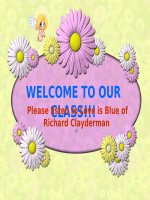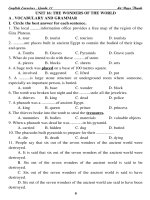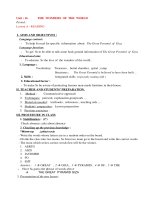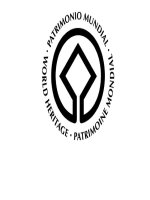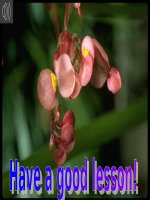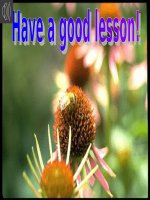Unit 16 (1)
Bạn đang xem bản rút gọn của tài liệu. Xem và tải ngay bản đầy đủ của tài liệu tại đây (59.78 KB, 12 trang )
Date of preparation : 9/4/2008
Periods: 97
Teaching date :
Unit 15. Man and the environment
A. animals and plants.( 1, 2, 3)
I. Aims and objectives.
- By the end of the lesson sts will be able to ask questions
with “ How much” and “ How many” and how to use the
indefinite quantifiers as some, alittle, a lot, a few. They know
more new words about animals and plants. Especially, they
got more knowledge about rare animals and how to protect
them, and the pollution of the environment.
II. Teaching aids.
Using student’s book, teacher’s book, board, chalk,
charts and pictures.
III. Anticipated problems.
1. Grammar: How much….?
How many…..?
2. Vocabulary: rice, cow, grow, buffalo, produce, ….
VI. Procedures.
Teacher’s activity
Student’s activity
1. Listen and repeat.
- Use pictures and some real
things as chalk, pens, books,
water to identify the
meanings a and usage of the
quantifiers: some, a few, a
little, a lot of.
- Let students listen and
repeat: some rice, a lot of
rice, a little rice, some eggs,
a lot of eggs, a few eggs.
then have them take note.
- Look at what the teacher
shows and notice the
meanings as well as the
usage of the quantifiers
some, a few, a little, a lot of.
- Listen and repeat.
Notes.
countable
uncountable
noun
noun
some eggs
some rice
a lot of eggs a lot of rice
Tim
e
- Have students read and
give the examples.
2. Listen and read. Then
answer the questions.
- Introduce the task.
- Give the picture and
introduce about Mr. Hai and
his farm and write on the
board the important details
you want to emphasize:
+ some paddy fields
+ a lot of rice
+ a few vegetables
+ a little fruit
+ a lot of eggs..
- Ask questions to check their
comprehension.
- Ask students to read the
passage again then practice
in pairs asking and answering
questions.
- Lets students copy the
passage in their notebooks
and write the questions and
answers.
- Give the key answers and
retell the usage of “ some, a
lot of, lots of, a few, a little”.
- Ask them to correct their
answers if there are any
mistakes.
a few eggs
a little rice
- Read and give examples.
- Listen to the teacher.
- Listen to the teacher’s
story and notice the details
written on the board.
- Try to retell the story,
using the details written on
the board.
- Answer the questions as
requested.
- Read the passage again
and practice asking and
answering in pairs.
P1.
P2.
- Copy the passage in the
notebooks, write the
questions ans answers.
a. He produce a lot of rice.
b. Yes, he does.
c. He produce a little fruit.
d. They produce a little milk.
e. They produce a lot of
eggs.
- Listen carefully to the
teacher’s key answers and
correct if there are any
3. Listen and write the
letter of the picture under
the right heading.
- Explain the purpose of the
practice. show them pictures
and introduce the new words:
“ greens” = green
vegetables.
- Let them listen to the
cassette and say the correct
quantifiers before the nouns
indicating farm produce.
- Call some students to retell
the right headings of each
items. Have them write the
whole sentences in their
notebooks keys.
mistakes.
- Listen to the teacher and
notice the word “ greens =
green vegetables”.
- Listen to the tape and give
the answer.
- Retell the right headings
and write the whole
sentences.
a. There are a lot of
potatoes.
b. There are some tomatoes.
c. There are a lot of onions.
d. There are a few
vegetables.
e. There is a little rice
f. There are some flowers.
Home work.
- Learn all new words and
- Copy the task.
structures.
- Do the home work in
exercise book.
Date of preparation : 9/4/2008
Periods: 98
Teaching date :
Unit 15. Man and the environment
A. animals and plants. ( 4, 5, 6).
I. Aims and objectives.
- By the end of the lesson sts will be able to talk about the
environment pollution. And know about the reasons why
some wild animals disappeared.
II. Teaching aids.
Using student’s book, teacher’s book, board, chalk,
charts and pictures.
III. Anticipated problems.
1. Grammar :
2. Vocabulary: burn, more, out down, in danger,
destroy, Asian.
VI. Procedures.
Teacher’s activity
Student’s activity
Tim
e
Warm up
- Have students give the big - Give the answer. ( maybe
serious problems of the
in Vietnames).
world.
+ population
+ environment pollution.
+ Chiến tranh hạt nhân.
nuclear war
+ poverty
Prereading.
- Introduce the new words.
- Copy the new words.
grow(v): tăng lên
cutdown(v): hạ gục, đốn hạ
burn(v): đốt cháy
to destroy(v): phá huỷ, tàn
phá
Asian(n): thuộc Châu á
be in danger: bị đe doạ, bị
nguy hiÓm.
- Repeat the new words.
- Have students repeat the
new words.
- Read the new words.
- Ask students read the new
words together and
individual.
While reading.
- Have students listen to the
- Listen to the tape.
tape two times.
- Ask students read the text.
- Read the text.
- Ask some students read the
text before class.
- Ask students answer the
questions.
- Have students give the
answers.
Remember.
- Ask say how to use : a lot
of, lots of, much, many, a
few, a little, more…
- Have students read a loud
words.
Home work.
- Learn all the new words.
- Do the exercise in exercise
book.
- Read the text.
- Answer the questions.
a. Because the are more
people.
b. Because they need more
fields.
c. Because we are
destroying plants and
animals.
- Give the answer.
- Read a loud.
- Copy the task.
Date of preparation : 14/4/2008
Periods: 99
Teaching date :
Unit 15. Man and the environment
B. pollution.( 1, 2).
I. Aims and objectives.
- By the end of the lesson sts will be able learn how to use
new
II. Teaching aids.
Using student’s book, teacher’s book, board, chalk,
charts and pictures.
III. Anticipated problems.
1. Grammar : Present progressive tense.
Present simple tense, do and don’t
2. Vocabulary: burn, more, out down, in danger,
destroy, Asian.
VI. Procedures.
Teacher’s activity
Student’s activity
Tim
e
1. Listen and read.
environm
- Have students play “
land
ent
Network” game with word :
Environment.
water
- Listen and copy the words.
- Introduce the words through wild(adj):
the game.
waste(v):
coal(n):
gas(n):
power(n):
air(n):
land(n):
ocean(n):
- Repeat the words.
- Have students repeat the
- Read the words.
words.
- Ask students read the words - Listen to the read the text.
together and individual.
- Have students listen to the
- Read the text.
text and read the text.
- Ask students read the text
- Answer the questions.
before the class.
- Give the answers.
- Ask students answer the
a. Because people are
questions.
destroying the forests.
- Have some students give
b. Gases are polluting the
the answers.
air.
c. The polution comes from
gases and trash.
d. Trash is polluting the land,
rivers and oceans.
2. Listen and read.
- Introduce the task of this
- Listen to the teacher.
part.
- Listen and copy.
- Introduce the new words.
- Read the words.
- Ask students read the new
words together and
individual.
- Ask students match the
rules with suitable pictures.
- Ask students compare the
answers with their friends.
- Ask students give the
answers.
- Do the task.
- Compare with friends.
- Give the answers.
Picture a: don’t damage
trees.
Picture b: save water
Picture c: don’t throw trash
on the street.
Picture d: collect bottles and
cans.
Picture e: keep off the grass.
Picture f: don’t pick flowers.
Picture g: collect papers.
Picture h: don’t trash in the
country.
- Check and correct if possile. - Listen to the teacher.
3. Play with words.
- Introduce the new words
- Listen and copy.
and have students read.
switch off(v):
turn off(v):
plant(v):
leave(v):
pick up(v):
collect(v):
- Ask some students read the - Read the text.
text.
Home work
- Learn all the new words.
- Copy the task.
- Do the exercise in exercise
book.
Date of preparation : 14/ 4/2008
Periods: 100
Teaching date :
Unit 15. Man and the environment
B. pollution.( 4-6).
I. Aims and objectives.
- By the end of the lesson sts will be able learn how to use
new
II. Teaching aids.
Using student’s book, teacher’s book, board, chalk,
charts and pictures.
III. Anticipated problems.
1. Grammar : Present progressive tense.
Present simple tense, should and shouldn’t.
2. Vocabulary: put, take, recycle, waste paper, scrap
metal, old plastic
VI. Procedures.
Teacher’s activity
Student’s activity
Tim
e
4. Listen and repeat.
- Introduce the task.
- Listen to the teacher.
- Introduce the new words.
- Listen and copy.
- Have students repeat the
- Repeat the words.
words.
- Read the words together
- Ask students read the words and individual.
together and individual.
- Listen to the tape.
- Have students listen to the
dialogue and read the
- Read the dialogue.
dialogue.
P1.
- Ask students read the
P2.
dialogue before the class.
P3.
5. Practice using should
and shouldn’t with a
partner. Write rules for a
picture.
- Introduce the task.
- Introduce the new words.
- Have students repeat the
- Listen to the teacher.
- Listen to the teacher and
copy.
- Repeat the words.
words.
- Ask students read the words
together and individual.
- Ask students practice with a
partner.
- Ask students read the rules
aloud before class.
- Have students write the
rules in their notebooks.
6. Listen and read. Then
answer the questions.
- Introduce the task.
- Introduce the new words.
- Have students repeat the
words.
- Ask students read the words
together and individual.
- Have students listen to the
text and read the text.
- Ask students read the text
before the class.
- Ask students answer the
questions.
- Have some students give
the answers.
- Read the new words.
- Practice with a partner.
- Read the rules.
- Copy the rules.
a. We shouldn’t leave trash
on the streets.
b. We should save water.
c. We shouldn’t damage
trees.
d. We should collect the
bottles and cans.
e. We shouldn’t pick flowers.
- Listen to the teacher.
- Listen and copy.
recycle(v):
waste food(n):
feed(v):
empty(adj):
waste paper(n):
scrap metal(n):
old plastic(n):
- Repeat the words.
- Read the words.
- Listen to the read the text.
- Read the text.
- Answer the questions.
- Give the answers.
a. In Viet Nam, we collect
and recycle many things.
b. We collect waste food and
feed it to pigs.
c. Factories collect and
recycle them.
d. Yes, I do.
e. I collect papers.
Home work
- Learn all the words.
- Do the exercise in the
- Copy the task.
exercise book.
- Review for second semester
test.
Grammar Practice
Period: 101
Lesson 6 :
Date of preparation:
Date of teaching:………….
01/5/ 2008
I. Aims : By the end of the lesson , students will be able to
revise all the structures from unit 12 to unit 14.
Skill : Listening , speaking , reading and writing
II. Teaching aids : Teacher and students’s book , pictures
III. Anticipated proplems
1, Sound
2, Vocaburaly
3, Grammar structure
4, Culture
IV, Procedures
Teacher’s activities
Students’ activities
1. Present simpe tense.
- Have students work in pairs and
do the exercise.
- Ask students give the answer.
- Check and give the right
- Practice in pairs.
- Give the answers.
a. Do you speak/ don’t/
speak
b. speaks
c. He speaks Chinese
d. He speaks Japanese
e. He speaks Viet Namese
f. He speaks English.
Tim
e
answers.
2. Present simple and present
progressive tenses.
- Introduce the exercise.
- Have students work in pairs and
do the exercise.
- Ask students give the answer.
- Check and give the right
answers.
3. Adjectives: Comparatives
and superlatives.
- Introduce the exercise.
- Have students do the exercise.
- Ask students compare their
answer with their friend.
- Ask students give the answer.
- Listen to and copy.
- Listen to the teacher.
- Do exercise.
- Give the answers.
a. is
b. lives
c. is / is staying
d. is
e. does/ teaches
f. Does she teach/ doesn’t/
teaches.
- Listen to and copy.
- Listen to the teacher.
- Do the exercise.
- Compare with friends.
- Give the answers.
long longer
the
short shortest longest
tall
taller
the
small smaller shortest
big
bigger
the
high higher
tallest
thick thickest the
- Ask students complete the
smallest
sentences with the suitable
the
adjectives.
biggest
- Ask students give the answers.
the
highest
thickest
- Complete the sentences.
- Give the answers.
a. longer / the longest
4. Indefinte quantifiers: a few,
a little, a lot of, lots of
- Introduce the exercise.
- Have students do the exercise.
- Ask students compare their
answer with their friend.
- Ask students give the answer.
b. the longest
c. the tallest/ taller/ the
tallest.
d. biggest/ bigger / the
biggest/ the biggest.
- Listen to the teacher.
- Do the exercise.
- Compare with friends.
- Give the answer.
a lot / a little/ a few
a lot / lots / a lot
- Check and give the right - Listen to the teacher and
answers.
check.
- Have students complete the
dialogue.
- Have some students practice
before class.
Home work.
- Redo all the exercises.
- Learn by heart all the words and - Copy the task.
structures for the test.
- Review for the second semester
test.
